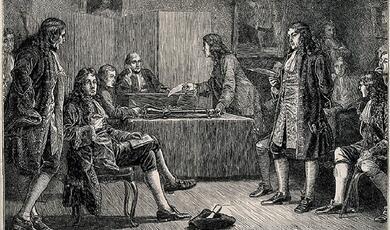Why conserve the Cutty Sark?
Share
- Details
- Text
- Audio
- Downloads
- Extra Reading
One of the main advantages of talking about Cutty Sark is being able to say this is a ship which needs no introduction. Richard Doughty, Chief Executive of Cutty Sark Trust, considers why this merchant sailing ship is so highly regarded around the world and why, despite the damage done by the fire in 2007, so much time and effort has been invested in conserving her original structure.
This is part of the Great Days of Sail Mondays at One series. The other lectures in this series are as follows:
The Greenlanders - Arctic whaleships and whalers
‘They live by Trade’: Britain’s global trade in the Great Days of Sail
Slavery, Ships and Sickness
Download Text
17 October 2011
Why Conserve the Cutty Sark?
Richard Doughty
Good afternoon. My name is Richard Doughty, and I am the Chief Executive of The Cutty Sark Trust. Gresham College have invited me here today to address the question:
Why Conserve the Cutty Sark?
One of the main advantages of talking about Cutty Sark is being able to say, without sparing anybody’s blushes, this is a ship which needs no introduction. Captain Moodie, her first captain, claimed she would ‘last forever’. So far he seems to have been proved right. Although she was built to have a working life of just thirty years, she is still with us 143 years on – nearly fivefold her original life expectancy.
Famously Cutty Sark survived the fire in May 2007 which stretched from stem to stern, and reached temperatures in excess of 1000oc. If there was anything positive that came out that day, it was that this was not just a local story, not even a national story, but an international story.The four corners of the earth were shocked at what they saw and heard on worldwide broadcasts.
I have always maintained Cutty Sark – the greyhound of the sea – is the best known historical vessel and for me that day proved it beyond the shadow of a doubt. In the week of the fire Cutty Sark received no less than six solid hours of mainstream television and radio coverage in the UK alone.But before I go any further I thought I should pause briefly and qualify my claim that Cutty Sark is the most famous ship in the world.
There is a wreck, not a ship, but a wreck dissolving some two and a half miles below the Atlantic Ocean, somewhere off the Newfoundland Banks. I believe I’m correct in saying Kate Winslett and Leonardo DiCaprio brought it back to public attention again in 1997 – you might recall the name…
Then of course there is Nelson’s flagship, well known in the UK but I suspect awareness falls off at a vast rate of knots the further you go from Portsmouth. And as far as the majority of Britons are concerned, USS Constitution,the most famous ship in the USA (pictured in the bottom right hand corner) is part of the Star Trek fleet!
Of course my tongue is planted firmly in my cheek but Cutty Sark is a ship which sailed to virtually every major port in the world. There is a very compelling argument Cutty Sark’s name transcends national boundaries.Put simply Cutty Sark is known everywhere around the globe.
Now I understand that there is a certain distiller of Scotch whisky who took her name back in the 1920’s and I cannot deny this spirit has played a part in keeping the ship’s name in the forefront of international conscience, but this in itself is a measure of the fame of the ship.
So this begs the question why should a merchant ship be so highly regarded?
Back in 1922 Captain Wilfred Dowman stood in Falmouth harbour watching a Portuguese brigantine called Maria do Amparo take refuge from a storm.
It was an unscheduled stop but nonetheless significant for that because Dowman recognised beneath her shabby exterior the unmistakable shape of a ship whose fame he’d known since he was a young cadet. He was convinced this was the very same clipper which had been an inspiration to him during his life at sea.
It was clear to Dowman Cutty Sark was in need of a saviour and he was determined to step up to the mark.
As it he happened failed to purchase the ship there and then but undeterred Dowman pursued her back to Portugal and after haggling for nearly a year he bought her.
Even so, he had to stump up well over her market value. On top of this he had to pay for the ship to be towed back from Portugal. But this was just the beginning; he then spent another fortune scouring the country for the materials needed to restore her back to her appearance when she sailed under the British ensign.
This was an incredible achievement, taking place, as it did, just four years after the First World War. But it was not without considerable personal sacrifice: it cost the family’s farm on the Trevissome Estate, as well as the training brigantine Lady of Avenal. The value of the farm today is well over £1 million and the ship arguably a similar amount.
Nevertheless Dowman single-handedly rescued Cutty Sark from the breakers’ yard and as such he was the ship’s first saviour.
Interestingly his intervention meant Cutty Sark was the first historic ship to be saved anywhere in the world and opened to the public since the pirate ship Golden Hindewas briefly put on display in Deptford Creek 350 years earlier.
Sadly Sir Francis Drake’s ship survived only three years because it was dismantled by souvenir hunters.
It is also a measure of her success that her name in 1922 still commanded headline news.
Returning to our friends, the wine merchants Berry Brothers & Rudd -
They were persuaded by the artist James McBey to adopt the name Cutty Sark for their new blended whisky destined to be sold in the United States because McBey had just read this very same newspaper notice whilst travelling on the train from Edinburgh to London to meet his future employers – the rest as they say is history.
The Cutty Sark was saved again in the 1950’s by HRH Prince Philip and Frank Carr, the then Director of the National Maritime Museum. One of the main reasons she was preserved at this time was to act as a permanent memorial to merchant service – who bore such heavy losses during the two world wars
A purpose built dry berth was constructed by McAlpine and the ship was floated into her new resting place where she was restored to her 1872 appearance.
Since 1957 she has been boarded by some 16 million people and seen by countless more millions visiting Greenwich or watching the London Marathon on television.
So if there is something magical about Cutty Sark which captivates all who see her. How do we explain this magic?
On the face of it, technically, Cutty Sark is not revolutionary in the way that the SS Great Britain was.
She is not a landmark – or should I say sea mark? – in the development of the ship.
She has a beautiful underwater shape, it is true, but she was not radically different from all the other clippers which had been evolving in the 19th century.
John Willis commissioned Cutty Sark from a young firm, Scott and Linton of Dumbarton, in Scotland.
They had never built a vessel of this size, although the designer Hercules Linton had been apprenticed in the yard of Alexander Hall of Aberdeen, the most innovative and prolific of clipper ship builders.
This is John Rennie’s original profile and plan of Cutty Sark 1869. Note the Foc’s’le accommodation in the bow and that the ship only had one deckhouse (the aft deckhouse added by 1872)
This shows Rennie’s half mid-ship section of Cutty Sark, 1869, possibly dating to before name assigned to ship.
The agreed price for the ship was £16,150. It was not enough to build a ship of the quality the contract specified, and Scott & Linton went into bankruptcy just before Cutty Sark was completed. The finishing touches were made by William Denny & Brothers.
There is what I have come to think of as a tide mark around the ship, where the quality of materials is not quite up to the same standard.
The Liverpool House is a case in point. Although the Master’s accommodation could happily grace any yacht – when we dismantled it during the conservation project it was obvious it had been reused from an earlier vessel.
Cutty Sark was built for the China tea trade. She usually carried over 1.3 million lbs of tea (equivalent to approximately 600,000 kg.) on each of her voyages back from China.
This is enough to make nearly 200 million cups of tea.
On her first three voyages, Cutty Sark sailed directly to China.
Later she would sail first to Sydney with a general cargo and pick up a thousand tons of Australian coal and sail on to Shanghai.
But her career as a tea clipper was actually remarkably brief – just eight years.
And yet under a particularly brilliant master, Richard Woodget, she had another spectacularly successful career…
But it was in one of the world’s least glamorous trades transporting bales of wool.
Cutty Sark entered the regular Australian Wool Trade in 1883 and found success as the ‘last chance saloon’ until 1895 when she was sold to the Portuguese firm J. Ferreira & Co, and renamed the Ferreira.
The main picture shows Cutty Sark in the early 1890’s when a single cargo of wool would, in today’s values, net over £7 million.
In 1888 Cutty Sark famously overhauled the P&O liner Britannia and suddenly she was a legend in her working life. From that point on people used to flock to see her when she was in port – either London or Sydney. She could do the return journey home from Australia in just 72 days.
So what exactly allowed this ship to travel so fast?
Cutty Sark is a composite ship – teak and rock elm planks bolted onto a wrought-iron frame.
Between 1864 and 1870, this was the most common form of construction for China tea trade ships.
Like an iron ship, the framework took up much less space than the frames on a wooden ship. This left more space for cargo as well as being much stronger.
The wooden hull planks were covered with Muntz metal. They were far more effective in stopping marine growth (which slowed ships down) than any of the then available anti-fouling treatments for iron ships.
There was also a prejudice that iron ships made the tea cargo ‘sweat’ if there was a sudden change in temperature.
But if timber was the traditional ship building material it was the wrought-iron frame with its integral structure and triangulation which was every bit as scientifically advanced as the Eiffel Tower or the Clifton Suspension Bridge.
This massively strong and stiff structure, together with the highly refined hull shape, was the key to her speed – the very thing which made her famous.
It was perhaps Captain Woodget alone who established her reputation as the fastest of this later flowering specimen of the sailing ship. This is why Cutty Sark can lay claim to being a unique ship.
And I think this is the key to understanding her enduring appeal.
Cutty Sark is not remembered because she carried tea back from China faster than any other ship,nor because she was the most successful wool clipper in the world, it is not even because she is one of just three composite built ships left in the world.
Few know these facts - few care
Cutty Sark is loved above all for what she represents.
It is 70 years since the end of commercial sail, yet we are still enthralled by the image of the sailing ship, a mass of white canvas ploughing over the seas at 17 knots.
Cutty Sark is a tangible reminder of another world
A reminder of a way of life just beyond grasp of human memory.
Of a technology that served us well for thousands of years and to this day provides great sport (Americas Cup).
That even today – out of sight out of mind – ships are as vital as ever for transporting goods around globe.
Cutty Sark is a simple, yet iconic, reminder of the importance of the sea in all our lives. A reminder that as an island nation, sea trade – not military might alone -- is what made us the prosperous nation we are today.
Furthermore, there are relatively few surviving ships which were so directly involved with the growth of trade, industry, employment and prosperity in this country and which helped to strengthen our international links.
Even in her own day she was symbolic of an earlier era, of a time when the sailing ship reigned supreme. And the clippers, although not quite the last word in sailing ships, were certainly the greatest development of the sailing ship in terms of speed.
At the beginning of the 21st century we are still enthralled by the excitement, the danger of the sailing ship – and so we are enthralled by this unique survivor of a bygone but never forgotten age, a symbol of adventure, of bravery, of pitting oneself against the elements, of the romance of sail.
Cutty Sark is one of those rare things which are: - truly emblematic and intrinsically inspiring
Quite simply a piece of history that cannot be remade
This is a picture of the ship in Cutty Sark Gardens, in Greenwich shortly before we started the conservation project.
Her beautiful appearance belies her very fragile condition.
We have been working very hard for the last decade to find the right solution for the ship. Our solution is no longer quite the one we originally conceived, but this has been the pattern of the project – development of ideas, revision and where necessary compromise.
In point of fact we have been working to create not just the right solution for the historic fabric of the ship, but also the right solution for ensuring that the ship has a sustainable future and that she is given the world class setting she deserves.
Cutty Sark was designed to withstand the hydrostatic forces on the hull by the sea and the loads of her cargo.
She was not designed to be sitting in a dry dock for long periods of time.
Being sat on her keel has resulted in sagging and bellying of the lower keel.
In addition the loads exerted by the props and shores resulted in local deformations of the hull.
Her iron framework is now too fragile to support both itself and the weight of her planks.
So our engineers have designed a new steel intervention to relieve her of most the stresses and strains of her own body by transferring the load down through twelve pairs of struts and ties into the ground.
This is Cutty Sark shortly before we lifted her. You can see the wonderful knife-shaped blade – the cutting edge of her bow and this is Cutty Sark in her new position supported by the twelve pairs of struts.
The new intervention provides even support around the hull and creates a completely new and unique experience.
We have quite literally lifted Cutty Sark into the 21st century.
For the first time visitors will be able to walk underneath, alongside and around a three masted sailing ship and see her incredible shape– the very thing which made her so successful. As I have said - the single most significant thing about Cutty Sark is her hull.
Raising the ship 3.3 metres also releases a thousand square metres of space under the ship, opening up the dry berth for a truly awe-inspiring experience, showcasing the beautiful lines of this record-breaking ship and giving a wonderful new perspective of the great design of the 19th century clipper.
This visual illustrates how we are planning to use this space for interpretation. In the foreground you can see the Star of India (designed by Maurice Lambert) which commemorates Cutty Sark’s role as a memorial to the men of the merchant navy who lost their lives in the two world wars.
1 in 5 merchant seamen during World War II was lost.
In the background you can see a choir of 80 figureheads – the largest collection of merchant figureheads in the world – fitting company for the original figurehead, the witch, ‘Nannie’
When we open at Easter next year, public access to the ship will be through a small aperture in the lower hold.
Egress is by means of a freestanding tower in Cutty Sark Gardens containing lifts and stairs. It has to be said this tower has not won unreserved approval but it meets the fire regulations and importantly enhances access for disabled visitors.
This view shows the underside of the gangway between the ship and the Access Tower.
But most of our time has been spent on the conservation of the historic fabric. This is the most fundamental aspect of the project.
More than the typhoons of the South China Seas, more than the storms of Cape Horn, it has been salt which has threatened Cutty Sark’s survival. Salt – absorbed from a life at sea and the 300 tons of gravel ballast she carried – which has corroded her fabric.
In order to develop an answer to how we were going to conserve the ship, we have had to become experts in corrosion in wrought iron and the treatment of decaying timbers. But this has never been a project about repairing the ship, or restoring the ship. Our project is about conserving Cutty Sark – of ensuring that the fabric of the ship that travelled to the South China Seas, that sailed round Cape Horn on the way back from Australia, is still with us throughout the 21st century.
There has been a persistent and highly vocal lobby who cannot understand why we don’t just cut out the rusted parts of the frames and weld in new pieces of steel, or replace decaying planks.
This is a legitimate view, but one which we have rejected. This would mean that one day we have a replica of Cutty Sark sitting in Cutty Sark Gardens:
Indeed it is my view that were we to have gone down this path we would have been creating a replica by stealth.
Instead our aim is to preserve as much of the original fabric as possible – we want to save as much of the ship that went to China that sailed to Australia, that was the record breaker as we possibly can.
That is the essence of Cutty Sark – the nineteenth century timbers of the hull.
Our entire project is rooted in this single desire, from the support structure to the treatment solutions for the corroded ironwork.
This slide shows the interior of the lower hold. The white frames are original nineteenth century frames. All the strengthening steel and support steelwork is painted grey so that any visitor will be able to see at a glance what is original and what is new.
I hope you will agree it is extraordinary how much fabric survives ‘as built’.
As a salutatory reminder of the fire I thought I would show you this photograph of the inside the lower hold the ‘day after’.
This is a similar view taken this summer illustrating how far we have come along our path to conserving and reinstating the ship.
Our Conservation Plan for the ship is 975 pages long, partly because it was important to understand the history of each element of the ship as well as assess its condition but partly because we take a broader view of what conservation means now.
It is not simply about treating rust, consolidating decaying timbers and providing adequate physical support.
It is also about providing a future for the ship.
After all, there is little point in investing millions and millions of pounds in treatments, strengthening, repairs and consolidation if there is no plan in place to ensure that the ship is a viable visitor attraction as well.
We see our business plan as very much part of the conservation plan.
It is not the driver of the conservation plan, but it is the operational blueprint to ensure Cutty Sark will remain one of London’s major visitor attractions, and – more – that it will have the ability to attract new audiences and new income streams to provide a substantial contribution towards long term future maintenance needs.
Our conservation plan for the ship is not a final solution – we have always planned on the basis that after this project the ship will need no major work until the middle of the century.
In another fifty years she will almost certainly need another major conservation project. We cannot plan for the distant future on the basis that there will be a Heritage Lottery Fund in 2062 to help us out again:
We must plan to generate surpluses from our own earnings to provide a substantial contribution – which, given the sums involved, means saving from day one.
Planning for fifty years in engineering terms is pretty impossible to predict. So we have instigated research and development in partnership with The University of Greenwich to create mathematical models of insidious decline in the fabric of the ship so that we can calculate and predict when we really do need to next intervene.
The importance of business planning has perhaps not always been fully understood in the heritage sector, but I hope that you can now see what we are trying to achieve.
Cutty Sark must live, not just as a tourist attraction, but as an icon of London, as a venue, literally as a flagship for enterprise, entrepreneurial activity, and quality.
These are the qualities the ship and our new interpretation scheme will espouse. She is, after all, a business machine and we need to ensure she can survive in the highly competitive market of 21st century visitor attractions.
In conclusion all I can say is if you think you’ve visited Cutty Sark – think again. You must come and see the conserved ship and discover how we are breathing new life into her.
Thank you.
©Richard Doughty, Gresham College 2011
This event was on Mon, 17 Oct 2011
Support Gresham
Gresham College has offered an outstanding education to the public free of charge for over 400 years. Today, Gresham College plays an important role in fostering a love of learning and a greater understanding of ourselves and the world around us. Your donation will help to widen our reach and to broaden our audience, allowing more people to benefit from a high-quality education from some of the brightest minds.


 Login
Login







